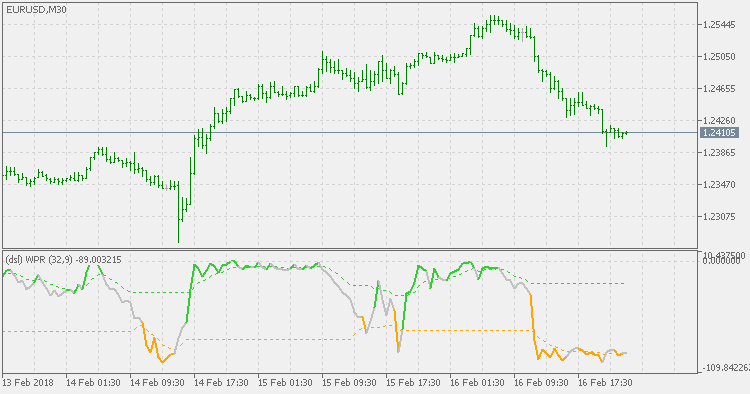Join our fan page
- Views:
- 6067
- Rating:
- Published:
-
Need a robot or indicator based on this code? Order it on Freelance Go to Freelance
Williams' Percent Range Technical Indicator (%R) is a dynamic technical indicator, which determines whether the market is overbought/oversold. Williams' %R is very similar to the Stochastic Oscillator. The only difference is that %R has an upside down scale and the Stochastic Oscillator has internal smoothing.
- Indicator values ranging between -80% and -100% indicate that the market is oversold.
- Indicator values ranging between -0% and -20% indicate that the market is overbought.
To show the indicator in this upside down fashion, one places a minus symbol before the Williams' Percent Range values (for example -30%). One should ignore the minus symbol when conducting the analysis.
The DSL version of Williams' Percent Range does not use fixed levels for oversold and overbought levels, but is having a sort of dynamic (discontinued signal lines) calculated to identify those levels. That makes it a bit more responsive to market changes and volatile markets.

 Nonlinear Kalman filter
Nonlinear Kalman filter
One more from the creations of John Ehlers - nonlinear Kalman filter.
 Kalman bands
Kalman bands
This is a conversion of Kalman bands originally developed by Igor Durkin. Values are the same as MetaTrader 4 version except that we are using possibilities that MetaTrader 4 does not have to make the indicator easier to use.
 DSL - stochastic
DSL - stochastic
The DSL (Discontinued Signal Line) version of Stochastic does not use a moving average in a classical way for signals, but is instead calculating the signal lines depending on the value(s) of the stochastic. Thus, we are having two things : a signal line and a sort of levels that can be used for overbought and oversold estimation.
 DSL - extended stochastic
DSL - extended stochastic
The usual average that is used for stochastic calculation is simple Moving Average (SMA). This (extended) version allows you to use any of the 4 basic types of averages (default is SMA, but you can use EMA, SMMA or LWMA too) - some are "faster" then the default version (like EMA and LWMA versions) and SMMA is a bit "slower", but this way you can fine tune the "speed" to signals ratio.